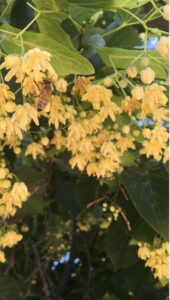In mid-June, the City of Denver confirmed the presence of the emerald ash borer (EAB)…
Say “Yes” to the Mess
Between life, work and home, we’re all busy bees these days. It seems like there is always one more thing on our never-ending list of to-dos. But when it comes to your home garden, we want to share an idea from Denver’s Office of the City Forester that will help keep your scene serene. Because keeping things pristine? That takes too much time. So, give yourself a rest and leave a little mess!
Think about the pollinators.
Flowers, fruits and leaves are great for pollinators. Having plenty of flowers and flowering trees around for pollinators is crucial to healthy pollinator populations, which are necessary for food production that we need as humans. It’s all connected.
Flowers, fruit and leaves are also good food sources and habitats for our insects and wildlife. Plus, embracing the messier side of landscaping is vital to maintaining a healthy urban ecosystem, because it helps to balance diseases and pests.
 Some trees attract bees.
Some trees attract bees.
In 2022 we planted this linden tree on request, as the property owner had a beehive and wanted them to have linden flowers to make their honey.
Leave some leaves.
Collecting leaves is a rite of fall. Raked piles make the cutest landing pads for our little ones and the colors somehow make the chore seem less like work and more like a nice way to get some cool crisp air in your lungs and not feel like you’re actually getting exercise too! But just say no to plastic and instead, responsibly dispose of leaves in compostable paper bags. You can get them for free from our LeafDrop program.
But don’t work too hard – try to leave a few leaves behind. Do a pass or two with your electric mower to chop up the leaves into small pieces for faster return of organic matter into the soil Creating compost from your organic food scraps and yard waste, like leaves, is a great way to make fuel for your trees, lawn and flower beds. Just add a little in when refreshing your mulch.
Besides leaves, how else do trees make an embraceable mess?
Some trees make their mess by dropping seeds, so they can adapt and reproduce the next generation. This post from our friends across the pond tells us about the five ways trees spread their seeds: the plant disperses them by gravity or force, or they spread seeds with a little help from animals, wind or water. Cleaning up after these trees hampers their hard work to survive.
As always, if you need more information, please contact Denver’s Office of the City Forester at forestry@denvergov.org or 720-913-0651.
